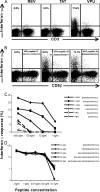Robust NK cell-mediated human immunodeficiency virus (HIV)-specific antibody-dependent responses in HIV-infected subjects
- PMID: 18353957
- PMCID: PMC2395196
- DOI: 10.1128/JVI.01952-07
Robust NK cell-mediated human immunodeficiency virus (HIV)-specific antibody-dependent responses in HIV-infected subjects
Abstract
Antibody-dependent cellular cytotoxicity (ADCC) is a potentially effective adaptive immune response to human immunodeficiency virus (HIV) infection. The study of ADCC responses has been hampered by the lack of simple methods to quantify these responses and map effective epitopes. We serendipitously observed that standard intracellular cytokine assays on fresh whole blood from a cohort of 26 HIV-infected subjects identified non-T lymphocytes expressing gamma interferon (IFN-gamma) in response to overlapping linear peptides spanning HIV-1 proteins. The effector cells were CD3(-) CD4(-) CD8(-) CD14(-) CD2(+) CD56(+/-) NK lymphocytes and degranulated granzyme B and perforin in response to antigen stimulation. Serum transfer assays demonstrated that the specific response was mediated by immunoglobulin G. Fresh blood samples from half of the HIV-infected cohort demonstrated robust HIV peptide-specific IFN-gamma expression by NK cells, predominately to Env, Pol, and Vpu HIV-1 proteins. Responses were readily mapped to define minimal epitopes utilizing this assay. Antibody-dependent, HIV-specific NK cell recognition, involving components of both innate and adaptive immune systems, represents a potentially effective immune response to induce by vaccination.
Figures







Similar articles
-
HIV-1 Env- and Vpu-Specific Antibody-Dependent Cellular Cytotoxicity Responses Associated with Elite Control of HIV.J Virol. 2017 Aug 24;91(18):e00700-17. doi: 10.1128/JVI.00700-17. Print 2017 Sep 15. J Virol. 2017. PMID: 28701393 Free PMC article.
-
Deficient IL-2 Produced by Activated CD56+ T Cells Contributes to Impaired NK Cell-Mediated ADCC Function in Chronic HIV-1 Infection.Front Immunol. 2019 Jul 16;10:1647. doi: 10.3389/fimmu.2019.01647. eCollection 2019. Front Immunol. 2019. PMID: 31379845 Free PMC article.
-
Specific antibody-dependent cellular cytotoxicity responses associated with slow progression of HIV infection.Immunology. 2013 Feb;138(2):116-23. doi: 10.1111/imm.12016. Immunology. 2013. PMID: 23173935 Free PMC article. Clinical Trial.
-
The role of HIV-specific antibody-dependent cellular cytotoxicity in HIV prevention and the influence of the HIV-1 Vpu protein.AIDS. 2015 Jan 14;29(2):137-44. doi: 10.1097/QAD.0000000000000523. AIDS. 2015. PMID: 25396265 Review.
-
Unlocking HIV-1 Env: implications for antibody attack.AIDS Res Ther. 2017 Sep 12;14(1):42. doi: 10.1186/s12981-017-0168-5. AIDS Res Ther. 2017. PMID: 28893275 Free PMC article. Review.
Cited by
-
Natural killer cells in patients with severe chronic fatigue syndrome.Auto Immun Highlights. 2013 Apr 16;4(3):69-80. doi: 10.1007/s13317-013-0051-x. eCollection 2013 Dec. Auto Immun Highlights. 2013. PMID: 26000145 Free PMC article.
-
Antibody-dependent cell-mediated cytotoxicity in simian immunodeficiency virus-infected rhesus monkeys.J Virol. 2011 Jul;85(14):6906-12. doi: 10.1128/JVI.00326-11. Epub 2011 May 18. J Virol. 2011. PMID: 21593181 Free PMC article.
-
HIV-1 Env- and Vpu-Specific Antibody-Dependent Cellular Cytotoxicity Responses Associated with Elite Control of HIV.J Virol. 2017 Aug 24;91(18):e00700-17. doi: 10.1128/JVI.00700-17. Print 2017 Sep 15. J Virol. 2017. PMID: 28701393 Free PMC article.
-
Fc receptor-mediated antiviral antibodies.Curr Opin HIV AIDS. 2009 Sep;4(5):388-93. doi: 10.1097/COH.0b013e32832f0a89. Curr Opin HIV AIDS. 2009. PMID: 20048702 Free PMC article. Review.
-
AIDS vaccine for Asia Network (AVAN): expanding the regional role in developing HIV vaccines.PLoS Med. 2010 Sep 21;7(9):e1000331. doi: 10.1371/journal.pmed.1000331. PLoS Med. 2010. PMID: 20877474 Free PMC article.
References
-
- Ahmad, A., and R. Ahmad. 2003. HIV's evasion of host's NK cell response and novel ways of its countering and boosting anti-HIV immunity. Curr. HIV Res. 1295-307. - PubMed
-
- Ahmad, R., S. T. Sindhu, E. Toma, R. Morisset, J. Vincelette, J. Menezes, and A. Ahmad. 2001. Evidence for a correlation between antibody-dependent cellular cytotoxicity-mediating anti-HIV-1 antibodies and prognostic predictors of HIV infection. J. Clin. Immunol. 21227-233. - PubMed
-
- Banks, N. D., N. Kinsey, J. Clements, and J. E. Hildreth. 2002. Sustained antibody-dependent cell-mediated cytotoxicity (ADCC) in SIV-infected macaques correlates with delayed progression to AIDS. AIDS Res. Hum Retrovir. 181197-1205. - PubMed
-
- Bour, S., and K. Strebel. 2003. The HIV-1 Vpu protein: a multifunctional enhancer of viral particle release. Microbes Infect. 51029-1039. - PubMed
MeSH terms
Substances
LinkOut - more resources
Full Text Sources
Other Literature Sources
Medical
Research Materials

